- News
- Reviews
- Bikes
- Accessories
- Accessories - misc
- Computer mounts
- Bags
- Bar ends
- Bike bags & cases
- Bottle cages
- Bottles
- Cameras
- Car racks
- Child seats
- Computers
- Glasses
- GPS units
- Helmets
- Lights - front
- Lights - rear
- Lights - sets
- Locks
- Mirrors
- Mudguards
- Racks
- Pumps & CO2 inflators
- Puncture kits
- Reflectives
- Smart watches
- Stands and racks
- Trailers
- Clothing
- Components
- Bar tape & grips
- Bottom brackets
- Brake & gear cables
- Brake & STI levers
- Brake pads & spares
- Brakes
- Cassettes & freewheels
- Chains
- Chainsets & chainrings
- Derailleurs - front
- Derailleurs - rear
- Forks
- Gear levers & shifters
- Groupsets
- Handlebars & extensions
- Headsets
- Hubs
- Inner tubes
- Pedals
- Quick releases & skewers
- Saddles
- Seatposts
- Stems
- Wheels
- Tyres
- Health, fitness and nutrition
- Tools and workshop
- Miscellaneous
- Cross country mountain bikes
- Tubeless valves
- Buyers Guides
- Features
- Forum
- Recommends
- Podcast
review
£1,200.00
VERDICT:
Comfortable, stable endurance bike with an innovative design, but not the lightest option out there.
Weight:
9,270g
Contact:
www.trekbikes.com
At road.cc every product is thoroughly tested for as long as it takes to get a proper insight into how well it works. Our reviewers are experienced cyclists that we trust to be objective. While we strive to ensure that opinions expressed are backed up by facts, reviews are by their nature an informed opinion, not a definitive verdict. We don't intentionally try to break anything (except locks) but we do try to look for weak points in any design. The overall score is not just an average of the other scores: it reflects both a product's function and value – with value determined by how a product compares with items of similar spec, quality, and price.
What the road.cc scores meanGood scores are more common than bad, because fortunately good products are more common than bad.
- Exceptional
- Excellent
- Very Good
- Good
- Quite good
- Average
- Not so good
- Poor
- Bad
- Appalling
Trek's Domane 2.3 offers impressive value for money and it's pretty effective at damping high frequency vibration. Compared to the higher-level Domanes in the range, we found its IsoSpeed compliance system to be a little limited.
Let's deal with the IsoSpeed Decoupler first, seeing as that's the Domane's unique selling point.
Decoupling
Okay, so on most bikes the seat tube is firmly attached to the rest of the frame at both the bottom bracket shell and at the top tube/seatstay junction, correct? (Okay, sometimes the seatstays join well below the top tube).
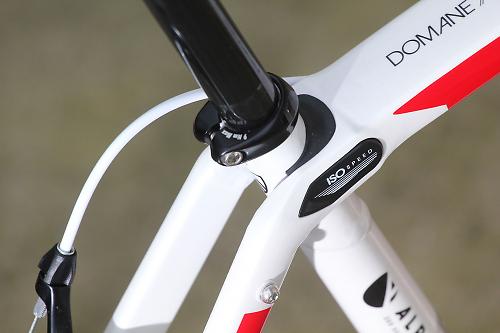
With the Domane (pronounced doh-mar-knee), the seat tube attaches at the bottom bracket like normal, but rather than being fixed at the top tube, there's a bearing between the two tubes. The idea is that the seat tube can pivot to a degree, so the saddle can move downwards (and a little backwards), providing more give and adding comfort to the ride.
The carbon Domane provides about 30mm of compliance. If you want to do something similar with aluminium, you need to be careful because when you flex aluminium it will fatigue over time.

For that reason, Trek have made the seat tube by welding two different sections of aluminium with differing characteristics, to determine the amount of vibration damping and compliance. The end result is that the aluminium Domane offers about half the amount of compliance of the carbon version. If you're worried that the aluminium might fail over time, Trek provide a lifetime warranty.
I found that the IsoSpeed Decoupler damped out high frequency vibration to an extent, and it helps to take the edge off bigger hits too – potholes, raised manholes and the like – but having ridden the carbon version last year, I wanted more. Still, you have to remember that this is a £1,200 bike whereas the carbon Domane 4 Series starts at £1,500. Anyway, I'll come back to the whole IsoSpeed system later with a more detailed look at the ride...
Construction & fit
The Domane 2.3, like the £1,000 2.0, is made from Trek's 200 Series Alpha Aluminium, and it's built to what Trek call their 'endurance fit', meaning that it's 'still racy but with a slightly higher head tube'.
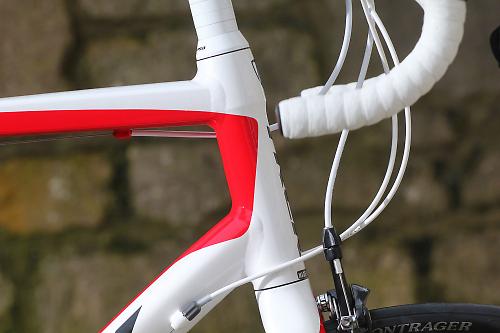
To put figures on it, we have the 58cm model here with a 54.8cm seat tube, a 56.7cm effective top tube, and a 19.5cm head tube. That's not a crazy-tall front end but it's pretty high.
For comparison, a 58cm Madone in Trek's H2 fit has an effective top tube that's 0.7cm longer and a head tube that's 0.5cm shorter. In a highly performance-orientated H1 fit, a 58cm Madone's effective top tube is 57.9cm and the head tube is 16cm.
In other words, the Domane's geometry is more relaxed than that of the Madone so you find yourself sitting in a more upright, less stretched out position. I don't like a particularly high front end to my bikes so I took out the headset spacers early on and got myself into a kind of medium position, but you could leave them in if you prefer your bars up high.
While we're on a geometry trip, the Domane has a slacker head angle than the Madone, a longer sweep to the fork and longer chainstays. The result is a significantly extended wheelbase – 1,022mm versus 987mm. That means that the Domane feels considerably more stable. It has a greater bottom bracket drop too, further adding to the stable feel.

Just a couple more figures: the headset is a standard (if there is such a thing these days) 1 1/8in top and bottom while the bottom bracket is Trek's own wide BB86.5 design. It's a press fit system that, unlike a few others we've used lately, remained creak-free throughout testing.
Usefully, as well as SpeedTrap compatibility (where a computer sensor can sit neatly inside the fork leg), Trek provide mudguard mounts front and rear that are hardly noticeable, and you get eyelets for a rear rack too. That makes a lot of sense on a bike that might well get used year round and be pressed into service for Audax and/or commuting.

The spec is based around Shimano's mid-level 105 groupset. The 105ness encompasses the shifters, mechs and the brakes. The only real compromise here is the Shimano R565 compact chainset that's not as light as a 105 version. Most of the rest of the kit comes from Bontrager, Trek's in-house brand.
The ride
The IsoSpeed Decoupler certainly does provide compliance – call it 'downward saddle movement' if you don't like the bike brochure jargon. You notice it most over rough roads where the bike smoothes over small bumps, holes and jaggedy bits.
The effect is quite hard to describe. It's not really like mountain bike suspension, or at least it's nothing like the same scale. We're talking about micro-movement here. The feeling is more like having a tyre with a lower than normal pressure in, but without any of the squirming or effects on handling (or risk of pinch flats!). In fact, Trek boast that there are no drawbacks to the Isospeed system. It adds very little weight and there's no impact on frame stiffness.

Trek have included other features to help keep the ride comfortable too. As I mentioned above, the carbon-legged fork has been designed to encourage give at the front end and you get 25mm Bontrager R1 tyres. The low-drop (125mm) Bontrager Race VR-C handlebar comes with Bontrager's thick gel/cork tape and Bonty's Affinity 1 saddle has a whole lot of padding throughout – too much for my taste although, as always with saddles, comfort comes down to personal preference.
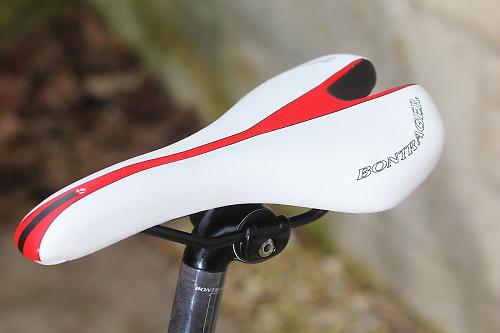
The result is a ride that feels just a bit smoother than you get with competitors at this price. I'd like to emphasise 'a bit' here. It's not chalk and cheese, black and white, day and night. You feel like you're riding a bike that's different, but not that different. There are carbon bikes out there that offer more compliance than you get here without the need for an IsoSpeed Decoupler to achieve it.
Aluminium versus carbon
I tried out a carbon Domane last year, albeit for just for one ride, and that was significantly different, both in dealing with high-frequency buzz and with bigger bumps. There was far more movement there. Maybe that's not a fair comparison because the carbon version is more expensive, but if you're sold on the idea of more compliance, do consider the Domane 4 Series seriously.
Of course, it's not quite as easy as that, because the carbon Domanes are more expensive. The cheapest, the 4.0, comes with a Shimano Tiagra build (Shimano's groupset level below 105) and costs £1,500. If you want the same spec as the 2.3 on a carbon Domane, you need the 4.3 that's priced at £1,800 – so you're effectively paying £600 extra for that extra compliance.

Another thing to consider is that the Domane 2.3 isn't the lightest £1,200 bike out there. Ours hit the road.cc Scales of Truth at 9.27kg (20.4lb). We're certainly not saying that weight is everything, but the £1,249 Giant TCR SL2 that we reviewed recently was almost a kilo lighter at 8.35kg (18.4lb).
Our Domane was in no way lethargic but it lacked the spark and energy of some similarly priced bikes when accelerating and climbing. It just needed that little bit more urging on to get up to speed, and I was glad of the compact chainset hooked up to a 12-30-tooth cassette when it came to tackling steep climbs. Lighter wheels would certainly help here, as they usually would. The Bontrager Approved rims on alloy hubs are perfectly sound and they've remained 100% true throughout testing, but they're not especially lightweight.
Good, but not quite the moon on a stick
Don't get the impression that the Domane 2.3 isn't a good bike. There's certainly a lot to recommend it. Trek are right to say that there's no loss of frame rigidity with the IsoSpeed Decoupler, for example. It's a pretty stiff bike at both the head tube and the bottom bracket, even when you get out of the saddle and throw it about.
It's a good level of spec for the money too. Shimano 105 is great stuff both in terms of function and durability – possibly Shimano's best balance – and all of the Bontrager kit is well thought-out too. If I'm being picky – and I am – I'd like lighter wheels... but I want the moon on a stick, me.

So, who should buy the Domane 2.3? Well, I would say that it's not the most manoeuvrable of bikes when riding in a group, and it's not the most reactive, but that's not really what the Domane is about.
It's at its best when you're cruising along, when all that stability I mentioned means it takes care of itself with the minimum of attention. And that decent level of comfort becomes more valuable the longer you're in the saddle, and for that reason it's a good option if you're likely to get in the big miles on long weekend rides, Audaxes or sportives.
Verdict
Comfortable, stable endurance bike with an innovative design, but not the lightest option out there.
road.cc test report
Make and model: Trek Domane 2.3
Size tested: 58cm
About the bike
State the frame and fork material and method of construction. List the components used to build up the bike.
Frame 200 Series Alpha Aluminum, IsoSpeed, press-fit BB
Fork Trek IsoSpeed carbon, SpeedTrap compatible
Wheels Alloy hubs w/Bontrager Approved alloy rims
Tyres Bontrager R1, 700x25c
Shifters Shimano 105 STI, 10 speed
Front derailleur Shimano 105, 31.8mm clamp
Rear derailleur Shimano 105
Chainset Shimano R565, 50/34 (compact)
Cassette Shimano Tiagra 12-30, 10 speed
Saddle Bontrager Affinity 1, steel rails
Seatpost Bontrager Carbon, 20mm offset
Handlebar Bontrager Race VR-C, 31.8mm
Stem Bontrager Race Lite, 31.8mm, 7 degree
Headset 1 1/8in integrated, semi-cartridge bearings
Brakeset Shimano 105 brakes w/Shimano 105 STI levers
Tell us what the bike is for, and who it's aimed at. What do the manufacturers say about it? How does that compare to your own feelings about the bike?
Trek say, "Domane 2 Series is the world's finest aluminum endurance bike. It features Trek IsoSpeed technology and our innovative endurance geometry for comfort and stability in all conditions."
It's certainly an endurance bike, at it's best for getting in the big miles in reasonable comfort.
Frame and fork
Overall rating for frame and fork
8/10
Tell us about the build quality and finish of the frame and fork?
You might be sceptical of the IsoSpeed Decoupler but it does add a degree of compliance - just not as much as you get with the carbon version of this bike.
Tell us about the geometry of the frame and fork?
I've discussed this in the text. Essentially, it's Trek's Endurance Fit which is more relaxed than one of their more race-orientated fits.
How was the bike in terms of height and reach? How did it compare to other bikes of the same stated size?
The reach is shorter than that of an equivalent Madone, and the stack is higher, giving a more relaxed ride position.
Riding the bike
Was the bike comfortable to ride? Tell us how you felt about the ride quality.
Yes, it was comfortable. If you're coming at it expecting tons of bump-gobbling suspension, you're going to be disappointed. Likewise, if you're expecting as much give as you get with a carbon Domane. The IsoSpeed Decoupler gives you just a little more compliance than you would otherwise get.
Did the bike feel stiff in the right places? Did any part of the bike feel too stiff or too flexible?
Yes, it's a clever trick but there's no apparent loss of frame stiffness with the IsoSpeed Decoupler.
How did the bike transfer power? Did it feel efficient?
Yep.
Was there any toe-clip overlap with the front wheel? If so, was it a problem?
The tiniest amount for me. Not a problem
How would you describe the steering? Was it lively, neutral or unresponsive? Certainly not lively or twitchy. The bike feels very stable.
Rate the bike for efficiency of power transfer:
7/10
Rate the bike for acceleration:
6/10
Rate the bike for sprinting:
6/10
Rate the bike for high speed stability:
8/10
Rate the bike for cruising speed stability:
8/10
Rate the bike for low speed stability:
8/10
Rate the bike for flat cornering:
7/10
Rate the bike for cornering on descents:
7/10
Rate the bike for climbing:
6/10
The drivetrain
Rate the drivetrain for performance:
8/10
Rate the drivetrain for durability:
8/10
Rate the drivetrain for weight:
8/10
Rate the drivetrain for value:
8/10
Wheels and tyres
Rate the wheels and tyres for performance:
6/10
Rate the wheels and tyres for durability:
7/10
Rate the wheels and tyres for weight:
6/10
Rate the wheels and tyres for comfort:
7/10
Rate the wheels and tyres for value:
7/10
Controls
Rate the controls for performance:
8/10
Rate the controls for durability:
8/10
Rate the controls for weight:
8/10
Rate the controls for comfort:
8/10
Rate the controls for value:
8/10
Your summary
Did you enjoy riding the bike? Kind of, but it was a bit too sedate for my taste.
Would you consider buying the bike? It wouldn't really suit me.
Would you recommend the bike to a friend? If they were after a comfortable endurance bike
Rate the bike overall for performance:
7/10
Rate the bike overall for value:
8/10
About the tester
Age: 41 Height: 190cm Weight: 75kg
I usually ride: My best bike is:
I've been riding for: Over 20 years I ride: Most days I would class myself as: Expert
I regularly do the following types of riding: time trialling, commuting, club rides, sportives, general fitness riding,
Mat has been in cycling media since 1996, on titles including BikeRadar, Total Bike, Total Mountain Bike, What Mountain Bike and Mountain Biking UK, and he has been editor of 220 Triathlon and Cycling Plus. Mat has been road.cc technical editor for over a decade, testing bikes, fettling the latest kit, and trying out the most up-to-the-minute clothing. He has won his category in Ironman UK 70.3 and finished on the podium in both marathons he has run. Mat is a Cambridge graduate who did a post-grad in magazine journalism, and he is a winner of the Cycling Media Award for Specialist Online Writer. Now over 50, he's riding road and gravel bikes most days for fun and fitness rather than training for competitions.
Latest Comments
- jpj84 1 sec ago
Seems a bit twee having "disc" in the bike name in 2025: of course it's got disc brakes, it's 2025😆
- mdavidford 9 min 29 sec ago
Quite right - get those soapboxes off our roads. As everyone knows, the right place for them is the internet.
- Bungle_52 12 min 44 sec ago
It's finally live. Here is the link :...
- mctrials23 13 min 46 sec ago
I sometimes feel like I am mad. Do they genuinely believe this sentencing is a deterrent. The driving standards in Ireland are a fucking joke and...
- David9694 14 min 4 sec ago
First warm and sunny weekend for the New Forest
- Rendel Harris 1 hour 17 min ago
The Michelin Power Gravel Adventure might fit your requirements, or the Vittoria Terreno Zero ("tubeless ready" but no reason you couldn't run it...
- hawkinspeter 1 hour 12 min ago
Council showing 'utter disregard' for people against Liveable Neighbourhood scheme:...
- hawkinspeter 1 hour 30 min ago
Better in some places and worse in others. There's still pletny of gridlock going on. I want them to bring back the rickety flyover by Temple Meads...
- lawrence18uk 11 hours 11 min ago
" in what appears to be two random, completely unprovoked attacks."...


























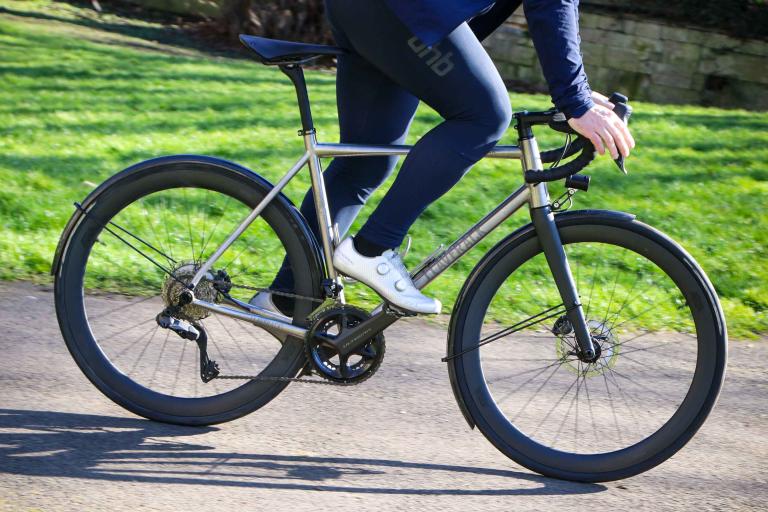


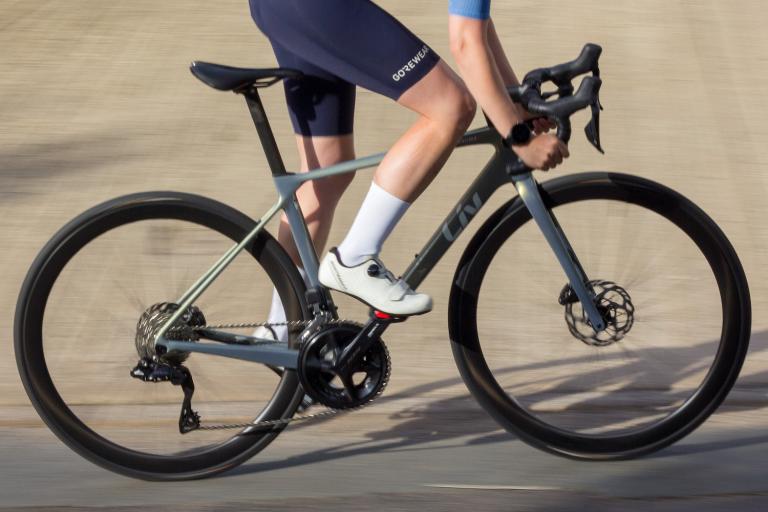
Add new comment
2 comments
If only they offered the carbon version as a frameset option (not the crazy-priced 6)...
What a monstrosity. Will be a pig to ride sure enough.